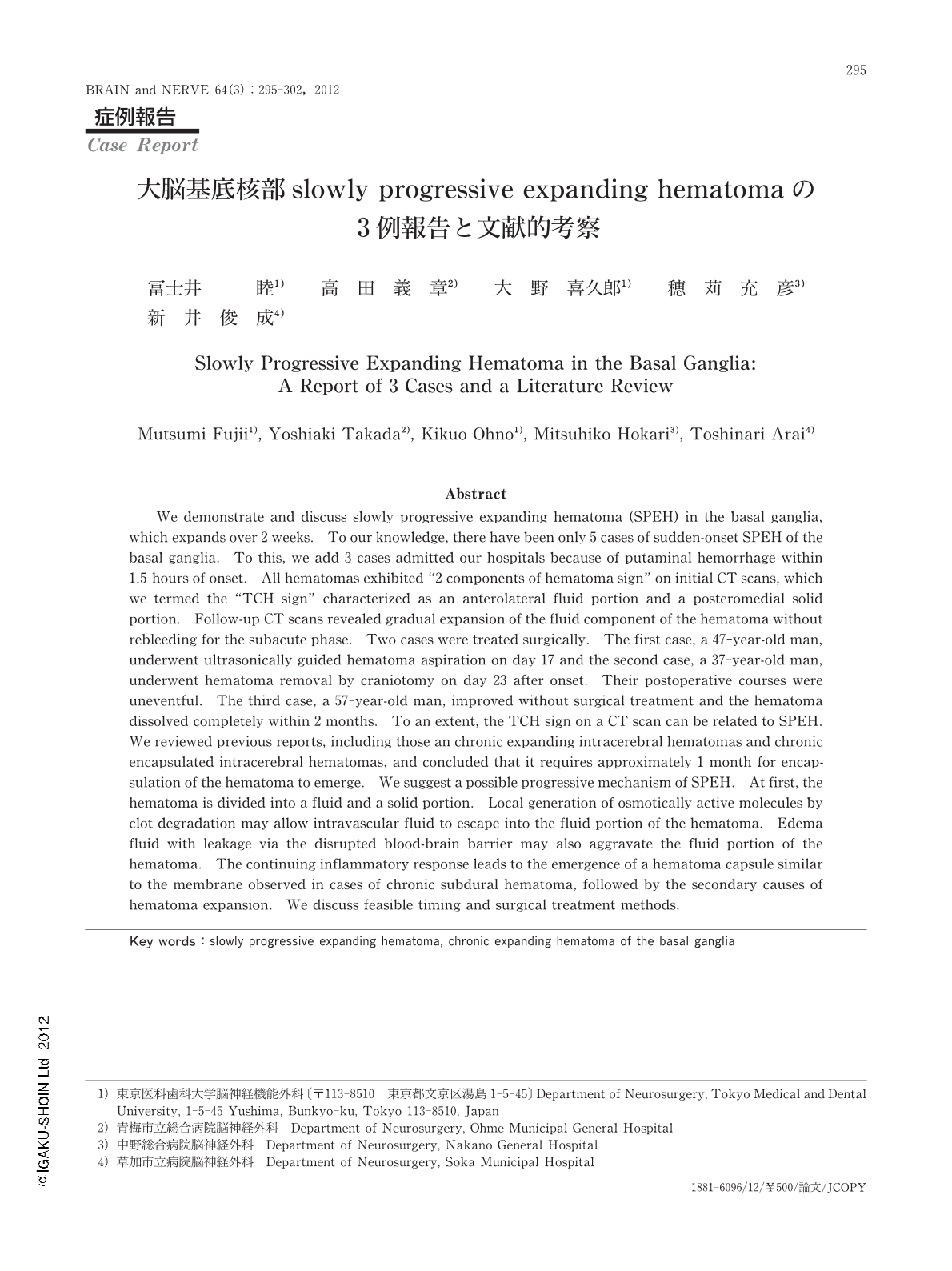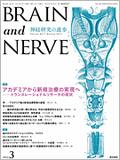Japanese
English
- 有料閲覧
- Abstract 文献概要
- 1ページ目 Look Inside
- 参考文献 Reference
はじめに
再出血のない被殼出血は,通常発症3日目以降は神経学的に改善しはじめ,14日目以降は画像所見上の脳浮腫も改善する経過をとるといわれている1)。したがって,14日目以降も出血腔が増大したり,脳浮腫が増悪して症状が改善しない症例には注意を要する。
緩徐に進行する脳内血腫は,1978年にYashonらによってchronic expanding intracerebral hematomaとしてはじめて提唱された2)。その後,chronic encapsulated intracerebral hematomaや,chronic expanding intracerebral hematomaとして緩徐な発症形式の脳内血腫は相次いで報告された3,4)。これらの大部分は大脳皮質下に存在し,大脳基底核部に発生するのは5%未満といわれている5)。今回われわれは,突然に発症し入院時は通常の高血圧性被殼出血と考えられたが,緩徐進行性に血腫が増大した症例を3例経験した。同様の基底核部の脳内出血は過去に5例,chronic intracerebral hematomaとして報告されてきたが6-8),皮質下発症のchronic expanding hematoma(CEH)と比べて出血の増大時期が発症2~4週間ごろとより早期であるため,slowly progressive expanding hematoma(SPEH)の呼称のほうが適切であろうと考える。したがって,本稿ではこの名称を使用し,3自験例をもとに文献上の検討を行い,併せて血腫増大の機序について考察する。
Abstract
We demonstrate and discuss slowly progressive expanding hematoma (SPEH) in the basal ganglia,which expands over 2 weeks. To our knowledge,there have been only 5 cases of sudden-onset SPEH of the basal ganglia. To this,we add 3 cases admitted our hospitals because of putaminal hemorrhage within 1.5 hours of onset. All hematomas exhibited "2 components of hematoma sign" on initial CT scans,which we termed the "TCH sign" characterized as an anterolateral fluid portion and a posteromedial solid portion. Follow-up CT scans revealed gradual expansion of the fluid component of the hematoma without rebleeding for the subacute phase. Two cases were treated surgically. The first case,a 47-year-old man,underwent ultrasonically guided hematoma aspiration on day 17 and the second case,a 37-year-old man,underwent hematoma removal by craniotomy on day 23 after onset. Their postoperative courses were uneventful. The third case,a 57-year-old man,improved without surgical treatment and the hematoma dissolved completely within 2 months. To an extent,the TCH sign on a CT scan can be related to SPEH. We reviewed previous reports,including those an chronic expanding intracerebral hematomas and chronic encapsulated intracerebral hematomas,and concluded that it requires approximately 1 month for encapsulation of the hematoma to emerge. We suggest a possible progressive mechanism of SPEH. At first,the hematoma is divided into a fluid and a solid portion. Local generation of osmotically active molecules by clot degradation may allow intravascular fluid to escape into the fluid portion of the hematoma. Edema fluid with leakage via the disrupted blood-brain barrier may also aggravate the fluid portion of the hematoma. The continuing inflammatory response leads to the emergence of a hematoma capsule similar to the membrane observed in cases of chronic subdural hematoma,followed by the secondary causes of hematoma expansion. We discuss feasible timing and surgical treatment methods.

Copyright © 2012, Igaku-Shoin Ltd. All rights reserved.


